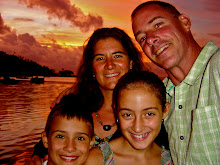In writing this week, we worked on using all the senses in describing a scene. Tica's earlier post, "The Five Senses of Bangkok," reflected this lesson. Here, Tica recounts of her visit to Wat Arun, drawing on the same concepts and putting them into a personal narrative. You can judge for yourself whether she succeeded. - Brooke
Whistles scream to inform passengers that the boat has arrived. The loud buzz from colorful long-tails fills the air. Tourist cameras click capturing the always busy Chao Praya River….
On Wednesday, we rose early and took an eye-poppingly pink taxi cab past four 7-Elevens, rows of street vendors and stores selling anything from sushi to fake Birkenstocks (“Birkenknocks”) all the way to the Thong Lor Skytrain station. We scanned our fare cards and the mechanical gates shot open. We hurried upstairs to the train platform as the heat poured over us like boiling water. What a relief to climb aboard the sleek, air-conditioned train.
We waited as the train sped westward over the city toward the river, listening to the drone of the television playing only advertisements and station announcements. When we finally got to the river taxi stop, the sound of squawking pigeons, boat horns and people chatting in Thai surrounded us. We climbed aboard a very crowded river taxi and sped by sparkling temples, warehouses, decaying homes, shiny new bridges and high-rises scattered along the riverbank.
King Rama VIII Bridge. Chao Praya River.
By the time we got to our stop, I was already tired. We took a small ferry across the river to Wat Arun, the Temple of the Dawn. We wandered past hoards of Japanese tourists, stone elephants decorated with flower offerings, statues of frightful looking demons and pictures of the King. When we finally got to the temple gate, there was a sign saying that visitors must be dressed appropriately. Of course, I was wearing exactly the wrong thing. The man at the desk waived us through though. We just gave him our tickets and walked right in.
This exquisite group of buildings was built in the mid-18th century during the Thonburi period of Thai history when the capital was located across the river from current day Bangkok. It has been attracting devotees and tourists ever since and it is such a striking and memorable image that it is depicted on the Thai 10 baht coin.
Wat Arun. Staircase to Second Tier.
We climbed to the second and highest level of the center pagoda. The steps were so steep and shallow that it felt like we were climbing a ladder. The view from up top was amazing. The Grand Palace complex and Wat Po stood across the river glistening in the sunlight. Closer in we saw details of the hand painted porcelain, chiming bells and even a few weeds growing out of the temple walls. People were praying and making offerings, monks in bright orange robes walked around the Monastery, and pigeons and stray cats climbed the terraces. It was quite a sight.
Grand Palace Complex as seen from Wat Arun.
When we reached the ground again we were hot and thirsty. A 10 baht coin bought us a bottle of nice, cold bottle of water and we headed back to the ferry toward Wat Po, the Temple of the Reclining Buddha and our next destination....







Wow, what a great piece of writing, Tika: you really have used all your senses.
ReplyDelete